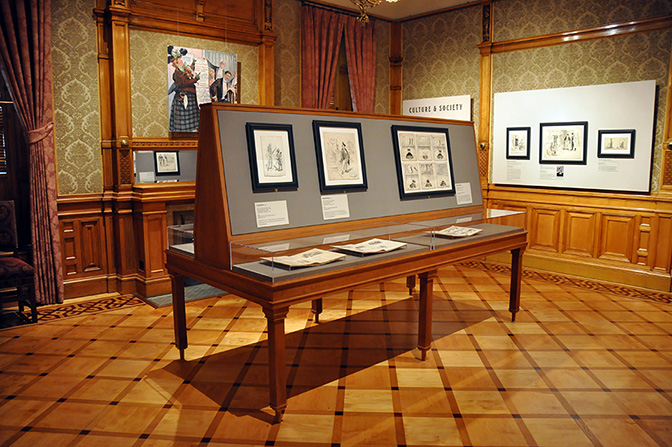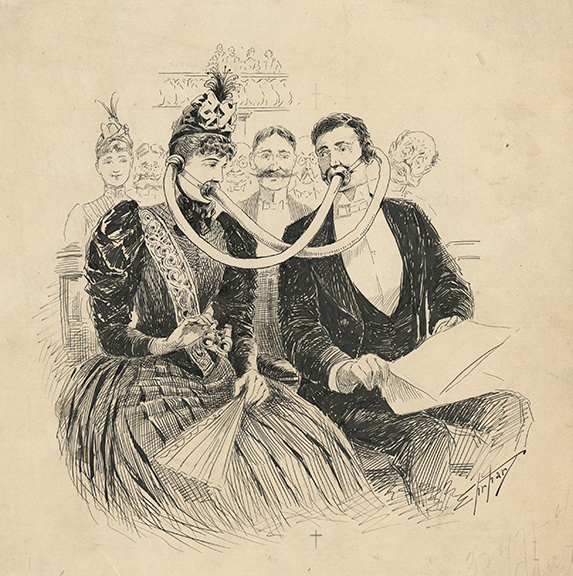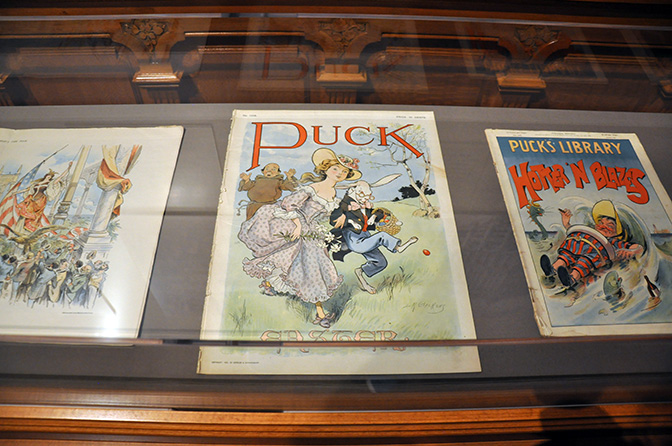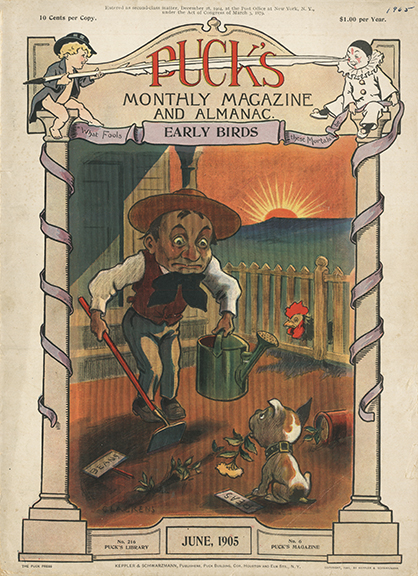“With a Wink and a Nod: Cartoonists of the Gilded Age”
The Driehaus Museum
40 East Erie Street
Chicago, Illinois, 60611
June 25, 2016 – January 8, 2017
These are truly strange transitional times we are presently living through. With countless overwhelming paradigm shifts occurring in so many quarters (cultural, philosophical, political, and technological) of society there is short-time to locate true reflection. And, with all of this uncertainty, there is a real need to find a touch of humor when seriously assessing the current state of our various collective dialogues and realignments. In “With a Wink and a Nod: Cartoonists of the Gilded Age”, currently on view at the Driehaus Museum through January 8, 2017, one can see how a similarly protean time was translated for the wider public through adept, insightful and satiric analysis by leading artists in the pages of Puck, America’s first successful humor magazine.

“With a Wink and a Nod: Cartoonists of the Gilded Age”, installation view, The Driehaus Museum, Chicago, Illinois,
June 25, 2016 – January 8, 2017
Immaculately curated and organized in collaboration with the Flagler Museum in Palm Beach, Florida, the exhibition covers a number of themes with diligent wit and prodding jocoseness. One encounters views of our progression into modern life, commentary on divisions of class and wealth, matrimonial meditations, straight-up cornball humor, and how recent immigrants were viewed in the Gilded Age. The exhibition is enchanting due to its directness and the artists’ mastery in rendering quotidian subtleties of the day.

“With a Wink and a Nod: Cartoonists of the Gilded Age”, installation view, The Driehaus Museum, Chicago, Illinois,
June 25, 2016 – January 8, 2017
Founded by Joseph Ferdinand Keppler in St. Louis, Missouri in 1871, Puck was initially published in English and German. Relocating 5 years later to New York City, the magazine continued to be published until 1918 and influenced the approach in newspaper and magazine cartooning and satire for decades. The magazine’s name stems from the mischievous fairy in Shakespeare’s “A Midsummer’s Night Dream”. This smart banner selection established an atmosphere and platform that supported unprecedented autonomy for artists and writers. No strata or kingdom was off limits. The pages are filled with pointed illustrations of such luminaries as President James A. Garfield, Hugh McLaughlin, President Theodore Roosevelt, and William Henry Vanderbilt. This impish perspective is echoed by Puck’s infamous line, “What fools these mortals be!”, which could be found in the upper third of the colorfully stylish covers.

Artist Louis Dalrymple (American, 1866-1905) tackled issues of modern womanhood and family in “Irony,” published in Puck’s Library “Jim-Cracks,” April 1896. The cartoon depicts a man who marries to settle into a quiet family life, but ends up at home with the children while his wife is out every night fighting for women’s rights. Collection of Jean S. and Frederic A. Sharf, courtesy of the Flagler Museum.
Puck was a true innovator through its implementing of full-color printing techniques on front and back covers, and centerfold, and employing leading artists (Louis Dalrymple, J. S. Pughe, Rose O’Neill, Eugene Zimmerman) of the highest caliber. The magazine’s attention to detail elevated illustrated satiric criticism to a true art form. Put simply, Puck set the highest of standards in terms of quality in humorous content and printing production, past and present. Included here are more than 70 original drawings, fully illustrated covers, and original copies of this seminal publication. One of the highlights of the exhibit is the ability to see the original drawings alongside the printed materials. In our time of digital age immediacy we often miss out on the sensual sensation of experiencing the tactile artfulness of the practitioner. However here, there is an intimacy through seeing the inked underdrawing, complete with flaws, being adapted to printed page.

In “The Theatre Conversationalist,” published in Puck, January 29, 1890, Samuel D. Ehrhart (American, 1862-1937) proposes a comical solution to a distraction that is still common today. The cartoon parodies high culture, fashion, and invention – topics common in Puck’s pages. Collection of Jean S. and Frederic A. Sharf,
courtesy of the Flagler Museum.
I visited “With a Wink and a Nod:…” with my wife as part of our recent wedding anniversary. We belly laughed at the cyclic nature of the materials on view. They reminded of our current political dramas, society’s perceptions of class, the vanity attached to our sense of fashion, and attitudes toward new immigrants. Puck offered a saucy awareness beyond the comical of a multi-faceted complex time and swiftly change country. This can be seen in Samuel D. Ehrhart’s “The Theatre Conversationalist”, 1890. On inspecting this work I thought, “Oh, my inability to capture every word she shares, such the fool I can be”. Nevertheless, this encounter will be remembered by us as a fruitful experience we will share for many years to come.

“With a Wink and a Nod: Cartoonists of the Gilded Age”, installation view, The Driehaus Museum, Chicago, Illinois,
June 25, 2016 – January 8, 2017
In addition to the noted, the Driehaus Museum is also presenting “Gilded Age Luxury,” featuring more than 15 objects in the museum’s collection, and “Women of Influence: Chicago’s Leading Ladies,” which outlines the cultural and social impact of prominent women who lived in the city during the Gilded Age. If you have not visited the Driehaus Museum, this is an ideal time to tour one of Chicago’s truly beautiful buildings and find a connection with a time that is distant in years, yet holds many parallels with our own.
Additional images from “With a Wink and a Nod: Cartoonists of the Gilded Age” at the Driehaus Museum:

“With a Wink and a Nod: Cartoonists of the Gilded Age”, installation detail, The Driehaus Museum, Chicago, Illinois,
June 25, 2016 – January 8, 2017

“Fashion’s Decree” by Louis M. Glackens (American, 1866-1933), from Puck’s October 2, 1907 issue, portrays the lengths to which people will go to adhere to fashion. Unfortunate women whose bodies do not conform to the next trend flock to a Turkish bath in hope of losing weight. Collection of Jean S. and Frederic A. Sharf, courtesy of the Flagler Museum.

As a response to popular demand, Puck’s Monthly Magazine and Almanac magazines reprinted cartoons and humorous verse from earlier issues of Puck.
Flagler Museum Archives.
For additional information, please visit:
The Driehaus Museum – http://www.driehausmuseum.org/exhibitions
Flagler Museum – http://flaglermuseum.us/with-a-wink-and-a-nod
Hathi Trust – https://catalog.hathitrust.org/Record/000495155
Installation photographs and review by Chester Alamo-Costello


